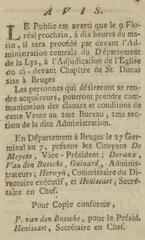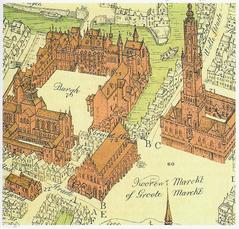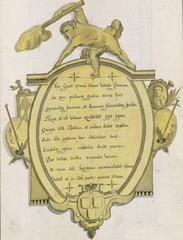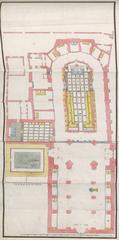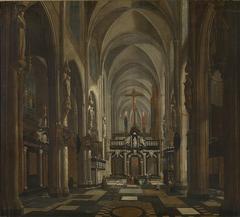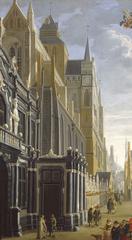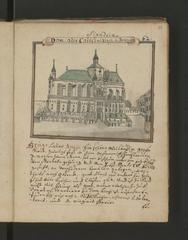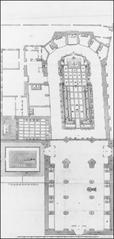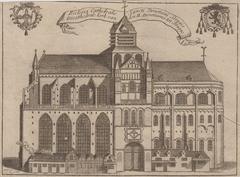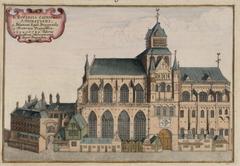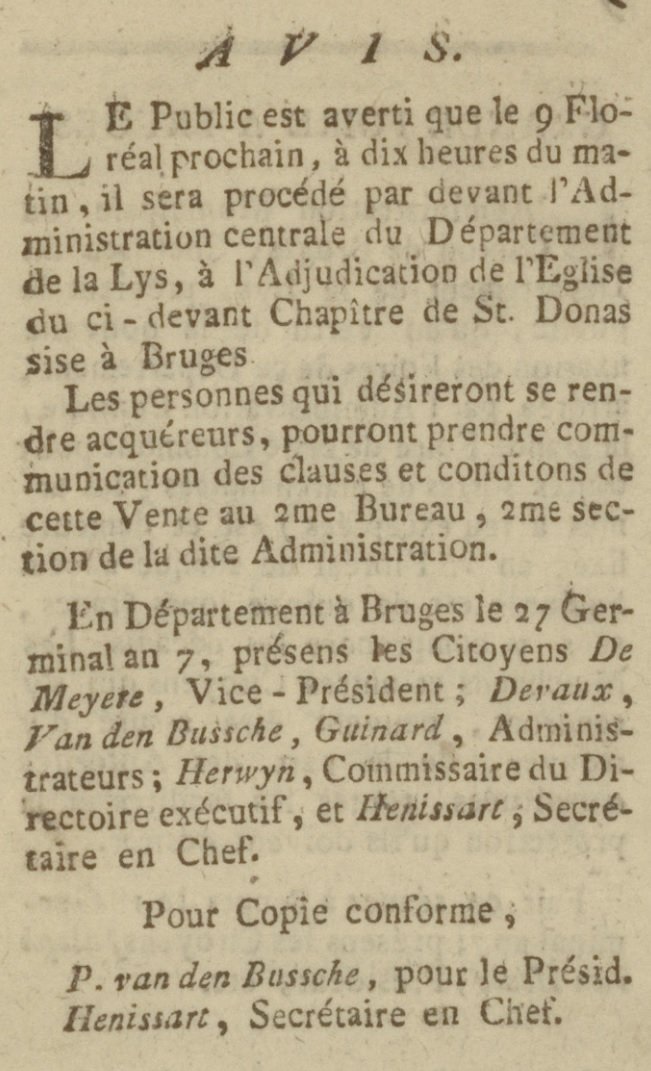
St. Donatian’s Cathedral Bruges: Visiting Hours, Tickets, and Historical Sites Guide
Date: 14/06/2025
Introduction: A Window into Medieval Bruges
Located at the heart of historic Burg Square, the site of St. Donatian’s Cathedral offers a compelling journey into Bruges’ medieval religious and civic heritage. Founded in the 10th century by Arnulf I, Count of Flanders, the cathedral once stood as the spiritual and administrative center of the city. Though demolished in 1799 during the French Revolutionary period, its archaeological remains—now preserved beneath the Crowne Plaza Brugge Hotel—grant visitors a rare, tangible encounter with Bruges’ storied past. This guide provides an in-depth overview of the site’s history, visitor information, accessibility, and surrounding attractions, ensuring a rewarding experience for anyone eager to explore Bruges’ layered heritage.
For up-to-date visitor details, consult the Visit Bruges Official Website and the Crowne Plaza Brugge Hotel.
Table of Contents
- Introduction
- The Cathedral’s Origins and Medieval Significance
- Architectural and Artistic Heritage
- Destruction, Rediscovery, and Modern Relevance
- Visiting Today: Location, Hours, and Tickets
- Site Features and Visitor Experience
- Accessibility and Practical Tips
- Nearby Attractions
- FAQs
- Conclusion
- References
The Cathedral’s Origins and Medieval Significance
St. Donatian’s Cathedral (Sint-Donaaskathedraal) was commissioned in the 10th century by Arnulf I to house the relics of Saint Donatian, which had been brought to Bruges in the 9th century. The church’s distinctive Romanesque design—with an octagonal core and a sixteen-sided ambulatory—signified both Bruges’ religious importance and its architectural innovation. Over time, Gothic elements were introduced, reflecting the city’s growing prosperity and evolving aesthetic tastes.
The cathedral was not only a center for worship but also played a pivotal role in Bruges’ social and civic life. It bore witness to significant historical events, such as the 1127 assassination of Count Charles the Good and the burial of Jan van Eyck, the renowned Flemish painter. St. Donatian’s also became a key pilgrimage destination, drawing visitors from across Flanders, especially during annual processions honoring its patron saint (EuroCheapo).
In 1562, the church was elevated to cathedral status, becoming the seat of the Diocese of Bruges. Adorned with a gilded dragon, it symbolized both civic pride and ecclesiastical authority, and its canons played an influential role in city governance.
Architectural and Artistic Heritage
St. Donatian’s Cathedral was celebrated for its blend of Romanesque and Gothic elements. Its grand nave, detailed choir, and ornate chapels showcased the wealth and devotion of Bruges’ citizens. The cathedral was also an artistic hub, housing significant religious relics and artworks that contributed to the flourishing of the fifteenth-century Bruges School of art. Many of these treasures were dispersed following the cathedral’s destruction, but the influence of its architecture endures in local ecclesiastical buildings.
Pilgrimage traditions flourished around Saint Donatian, with devotees seeking his protection from floods and water disasters. The cathedral’s prominence helped to establish Bruges as a center of medieval religious life and artistic production.
Destruction, Rediscovery, and Modern Relevance
The French Revolutionary occupation led to the cathedral’s demolition in 1799, marking the end of an era for Bruges’ ecclesiastical dominance (EuroCheapo). The site remained vacant until archaeological excavations in the mid-20th century revealed substantial remains—foundations, walls, and elements of the choir gallery. Construction of the Crowne Plaza Hotel in the 1980s integrated these ruins into its basement, creating an accessible archaeological site that uniquely blends ancient and modern Bruges.
Today, the site stands as a testament to the city’s resilience and serves as an educational and cultural resource for residents and tourists alike.
Visiting Today: Location, Hours, and Tickets
Location and Access
The archaeological remains of St. Donatian’s Cathedral are found beneath the Crowne Plaza Brugge Hotel, Burg 10, 8000 Brugge. Entry is through the hotel lobby; staff can direct visitors to the basement where the site is preserved. The location is central, opposite Bruges City Hall and steps from the Basilica of the Holy Blood, making it an ideal starting point for exploring Burg Square.
Visiting Hours
- The site is generally open during the hotel’s daytime hours, typically 10:00–18:00. However, access may be restricted during private events or hotel functions.
- It is strongly recommended to check in advance with the Crowne Plaza Brugge Hotel or by phone at +32 50 44 68 44 for the most current visiting times.
Tickets and Entry Fees
- Admission to the archaeological remains is free of charge for hotel guests and the general public.
- No reservation is required, but group visits or guided tours should be arranged in advance.
Site Features and Visitor Experience
Descending into the hotel’s basement, visitors discover the exposed foundations and partial walls of the former cathedral, highlighted by glass panels and subtle lighting. Interpretive displays in Dutch, French, and English provide historical context, including the cathedral’s significance as the burial site of Jan van Eyck and its connection to the legendary gilded dragon.
Artifacts uncovered during excavations—ceramic plates, tools, and artwork fragments—are on display. The quiet, contemplative atmosphere offers a powerful contrast to the vibrant activity above in Burg Square.
- Duration: Plan 20–40 minutes to explore the site and read interpretive materials.
- Photography: Permitted, but flash is discouraged to protect the remains.
- Languages: Information panels are available in Dutch, French, and English.
Accessibility and Practical Tips
- Accessibility: The site is accessible via elevator and lowered footpaths, making it suitable for visitors with limited mobility. Accessible restrooms are available in the hotel.
- Best Times to Visit: Early mornings or off-peak seasons (March–May, September–November) offer a quieter experience.
- Amenities: The hotel has a restaurant and restrooms; many cafés and shops are nearby.
- What to Wear: Comfortable shoes are recommended due to uneven surfaces in the basement.
Nearby Attractions
Burg Square is home to several of Bruges’ most important landmarks:
- Bruges City Hall (Stadhuis): A Gothic masterpiece dating from the late 14th century.
- Basilica of the Holy Blood: Houses a revered relic and hosts the annual Procession of the Holy Blood.
- Liberty of Bruges and Blind Donkey Alley: Both steeped in local history and legends.
- The Belfry: The iconic medieval bell tower, a short walk away.
Combine your visit to St. Donatian’s Cathedral with these sites for a comprehensive exploration of Bruges’ historic center.
FAQs
Q: Can I visit St. Donatian’s Cathedral today?
A: While the above-ground cathedral is gone, visitors can explore its underground remains beneath the Crowne Plaza Brugge Hotel.
Q: Is there an entrance fee?
A: No, entry is free for both hotel guests and the general public.
Q: What are the visiting hours?
A: Typically from 10:00 to 18:00, but check ahead to avoid closures during private events.
Q: Is the site accessible for wheelchair users?
A: Yes, via elevator and accessible footpaths.
Q: Are guided tours available?
A: No regular guided tours, but broader Bruges walking tours often include information about the site. Check with the Bruges Tourist Office.
Q: What nearby sites should I visit?
A: Don’t miss Bruges City Hall, Basilica of the Holy Blood, and the Belfry, all within a few minutes’ walk.
Conclusion
St. Donatian’s Cathedral remains a cornerstone of Bruges’ medieval legacy. Its preserved archaeological site invites visitors to step beneath the city’s vibrant surface and connect directly with centuries of religious, artistic, and civic history. With free entry, central location, and proximity to Bruges’ most iconic sites, a visit to St. Donatian’s Cathedral is an enriching experience for travelers of all interests.
Before your visit, confirm hours and possible restrictions, and consider using the Audiala app for guided audio tours and insider tips. Enhance your exploration with stops at nearby historical landmarks and soak in the unique atmosphere of Burg Square—a living testament to Bruges’ enduring heritage.
References and Further Reading
- Visit Bruges Official Website
- Crowne Plaza Brugge Hotel
- EuroCheapo: Bruges Underground Church Visit for Free
For more historical insights and travel tips, follow us on social media and download the Audiala app for up-to-date visitor information and audio tours.
